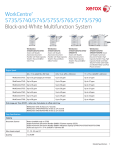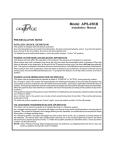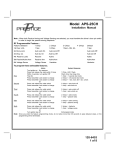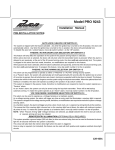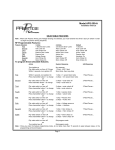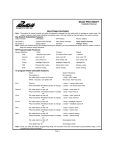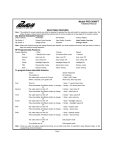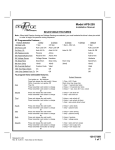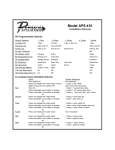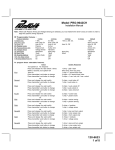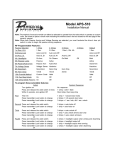Download Audiovox Garage Door Control Installation manual
Transcript
Model APS-15KB REMOTE CONTROL AUTO SECURITY SYSTEM Installation Manual PRE-INSTALLATION NOTES: PASSIVE / ACTIVE ARMING SELECTION: This alarm can be programmed to operate as either a “PASSIVE” or “ACTIVE” arming security system. As a “Passive” alarm, the system will automatically arm itself approximately 30 seconds after the ignition key is turned off, one door is opened, then all vehicle doors are closed, (arming is suspended until the last door is closed). This feature protects the vehicle in the event you forget to arm the system using the keychain transmitter. This system is shipped in the passive mode, therefore no modifications are required to make the system operate as a “Passive” alarm. As an “Active” alarm, the system can only be armed using the keychain transmitter. There will be no backup automatic arming. Caution: Be certain the module is disconnected from the main wiring harness before attempting to cut the wire loops. This will prevent shorting of the control module and any damage to the vehicle. To make the system operate as an “Active” alarm, open the access door located in the module's case, and cut the small Black Loop Wire. VOLTAGE SENSE / HARDWIRE SELECTION: This alarm can be wired to operate as a Voltage Sensing or a Hardwire system. As a voltage sensing system, the alarm will trigger any time an entry point that illuminates a courtesy light is opened. The system is shipped in the voltage sensing mode, therefore, no modifications are required to make this system a voltage sensing alarm. As a hardwire system, the alarm will trigger any time a door, hood, trunk, etc. is opened, by wiring directly to the switches. This means that if the courtesy light is burned out, or the courtesy light fuse is blown, the alarm will continue to protect all points of entry. Caution: Be certain the module is disconnected from the main wiring harness before attempting to cut the wire loops. This will prevent shorting of the control module and any damage to the vehicle. To make this system operate as a hardwire alarm, open the access door located in the module's case, and cut the small Green Loop Wire. NOTE: When “Passive Arming” and “Voltage Sensing” are selected, you must hardwire the driver’s door pin switch or passive arming will not be initiated. STARTER DISABLE: This system provides an output to control an optional starter cut relay (not included). When this option is installed, any time the system is armed, the vehicles starting circuit is inoperable. CHANNEL 2 OUTPUT: This system provides an additional hardwire remote output to control an assortment of optional upgrades. This output is an independent channel from the transmitter and is controlled by button #2 on the transmitter. It is a delayed ground pulse (300 mA maximum), and can be used to control: l Optional trunk release relay AS-9256 l Optional remote starter AS-9075 l Optional window roll up AS-9153 CHANNEL 3 : (TRANSMITTER ONLY) The transmitters included in this alarm incorporate an additional independent 3rd radio channel. Although the alarm module will only respond to 2 channels, the 3rd radio channel can be programmed to an option garage door interface (AS-9154). The AS-9154 has its own on-board programmable receiver and is designed to operate with most existing automatic garage door openers. In addition, the garage door interface receiver can be directly wired into the vehicle to offer a 3rd remote control option. Since this is a set of relay contacts, the receiver can be used to provide a selectable positive or negative pulse. TRANSMITTER PROGRAMMING: The transmitters included in this kit have been programmed at the factory for channel 1 (arm, disarm, and panic function) only. Any additional functions of the system must be programmed at the time of installation. These functions can be assigned to transmitter button 2, or a simultaneous press of both buttons 1 and 2. Refer to the transmitter programming guide, included in this package, for more details regarding transmitter button assignments and system functions. INSTALLATION OF MAJOR COMPONENTS: CONTROL MODULE: Select a mounting location inside the passenger compartment (up behind the dash) and secure using two screws provided. The control module can also be secured in place using cable ties. Do not mount the control module in the engine compartment, as it is not waterproof. You should also avoid mounting the unit directly onto factory installed electronic components. These components may cause RF interference, which can result in poor transmitter range or intermittent operation. SIREN: Select a mounting location in the engine compartment that is well protected from access below the vehicle. Avoid areas near high heat components or moving parts within the engine compartment. To prevent water retention, the flared, or opened end, of the siren must be pointed downward when mounted. Mount the siren to the selected location using the screws and bracket provided. HOOD OR TRUNK PIN SWITCH: A pin switch is included for use in protecting the hood or trunk ( or hatchback ) of the vehicle. The switch must always be mounted to a grounded, metal surface of the vehicle. It is important to select a location where water cannot flow or collect and to avoid all drip gutters on hood and trunk fender walls. Choose locations that are protected by rubber gaskets when the hood or trunk lid is closed. The pin switch can be mounted using the bracket provided, or direct mounted by drilling a ¼ “ diameter mounting hole. Keep in mind that when properly mounted, the plunger of the pin switch should depress at least ¼ “ when the hood or trunk lid is closed. DASH MOUNTED LED: 2 Pin Connector A small red LED is included that will serve as a visual indicator of the alarm status. It should be installed in the dash, located where it can be easily seen from outside the vehicle, yet not be distracting to the driver. Once a location has been selected, check behind the panel for wire routing access, and to confirm the drill will not damage any existing components as it passes through the panel. Drill a 15/64" diameter hole and pass the red and blue wires from the LED through the hole from the front of the panel. Firmly press the body of the LED into the hole until fully seated. Route the two pin connector toward the control module previously mounted. VALET SWITCH: 2 Pin Connector Select a desired mounting location for the switch, that is easily accessible to the driver of the vehicle. The switch does not have to be concealed, however, concealing the switch is always recommended, as this provides an even higher level of security to the vehicle. The switch may be mounted in or below the dash by drilling a 1/4" diameter hole in the location. Be sure to check behind the dash for adequate clearance for the body of the switch, and to confirm that the drill will not damage any existing components as it passes through the dash. Route the two pin connector toward the control module previously mounted. SHOCK SENSOR: 4 Pin Connector Select a solid mounting surface for the shock sensor on the firewall inside the passenger compartment, Page 2 and mount the sensor using the two screws provided. The shock sensor can also be secured to any fixed brace behind the dash using tie straps. Whichever mounting method is selected, make certain that the sensitivity adjustment is accessible for use later in the installation. WIRING THE SYSTEM: WHITE WIRE: + 12 VDC PULSED PARKING LIGHT OUTPUT ( 15 A MAX ) This wire is provided to flash the vehicle’s parking lights. Connect the white wire to the positive side of one of the vehicle’s parking lights. RED FUSED WIRE - (VOLTAGE SENSING): + 12 VDC CONSTANT BATTERY SOURCE This wire controls the sensitivity of the voltage sensing circuit, which detects the turning on of an interior light when a door is opened. It will also detect the switching on of parking or headlamps and in many cases will trigger the alarm when a thermostatically controlled electronic radiator cooling fan switches on. It is recommended that when installing this system into vehicles with electronic “after fans”, the procedure for RED FUSED WIRE - (HARDWIRE) should be followed. In voltage sensing applications, the closer to the battery that the red fused wire is connected, the less sensitive the voltage sense circuitry will be. Moving this connection point to the fuse panel will increase the sensitivity and connecting to the courtesy lamp fuse in the vehicle will provide maximum sensitivity of the voltage sense circuit. RED FUSED WIRE - (HARDWIRE): + 12 VDC CONSTANT BATTERY SOURCE When hardwiring the control module to pin switches at all entry points, the voltage sense circuit must be disabled. Cut the green wire loop from the alarm control module. Connect the red fused wire to a + 12 VDC constant battery source. DARK BLUE WIRE: 300 mA PULSED OUTPUT/CHANNEL 2 The dark blue wire pulses to ground via an independent RF channel from the keychain transmitter. This is a transistorized, low current output, and should only be used to drive an external relay coil. WARNING: Connecting the dark blue wire to the high current switched output of trunk release circuits, or some remote starter trigger inputs, will damage the control module. Connect the dark blue wire to terminal 86 of the AS-9256 relay (or equivalent 30 A automotive relay), and wire the remaining relay contacts to perform the selected function of channel 2. WHITE w/ BLACK TRACE WIRE: POSITIVE OUTPUT TO SIREN Route this wire through a rubber grommet in the firewall, and to the siren location. Connect the white/black wire to the positive wire of the siren. Secure the black ground wire of the siren to chassis ground. BLACK WIRE: CHASSIS GROUND Connect this wire to a solid, metal part of the vehicle’s chassis. Do not confuse this wire with the thin black antenna wire that exits the control module independently. YELLOW WIRE: + 12 VDC IGNITION SOURCE Connect this wire to a source that is hot when the key is in the on and in the crank positions. The source must be off when the key is in the off position. DARK GREEN WIRE: (-) INSTANT TRIGGER This is an instant on ground trigger wire. It must be connected to the previously installed hood and trunk pin switches. BROWN WIRE: - DOOR TRIGGER If the vehicle’s door courtesy light switches have a - ground output when the door is opened (GM and most Imports) you must connect this wire to the negative output from one of the door switches. In most cases, the brown wire will Page 3 only need to be connected to one door switch, no matter how many doors the vehicle has. WARNING: Do not use the brown wire if the vehicle has + 12 Volt output type door switches. (see PURPLE WIRE) PURPLE WIRE: + DOOR TRIGGER If the vehicle’s door courtesy light switches have a + 12 volt output when the door is opened ( most Fords and some Imports ), you must connect this wire to the positive output from one of the door switches. In most cases, the purple wire will only need to be connected to one door switch, no matter how many doors the vehicle has. WARNING: Do not use the purple wire if the vehicle has ground output type door switches. (see BROWN WIRE) ORANGE WIRE: GROUND OUTPUT WHEN ARMED This wire is provided to control the optional (not included) starter cut relay. Connect the orange wire to terminal 86 of the AS-9256 relay (or equivalent 30A automotive relay), and wire the remaining relay contacts as shown in the wiring diagram. IMPORTANT: Audiovox does not recommend using this relay to interrupt the ignition wire. Only connect this relay to the low current starter solenoid feed wire, as indicated on the wiring diagram of the AS-9256. VALET SWITCH: 2 Pin Blue Connector Route the grey and black wires in the 2 pin connector from the valet switch to the control module, and plug it into the mating blue connector on the side of the module. DASH MOUNTED LED: 2 Pin White Connector Route the red and blue wires in the 2 pin white connector from the LED to the control module, and plug it into the mating white connector on the side of the module. RED & GREEN 2 PIN CONNECTOR: DOOR LOCK OUTPUTS These wires will provide either a pulsed ground output to the factory door lock control relay, or a pulsed + 12 volt output to the factory door lock control relay. In either case, the maximum current draw through these outputs must not exceed 300 mA. 3 Wire Ground Switched Door Locks In this application, the red wire provides a ground pulse during arming (pulsed ground lock) output. Connect the red wire to the wire that provides a low current ground signal from the factory door lock switch to the factory door lock control relay. The green wire provides a ground pulse during disarming (pulsed ground unlock) output. Connect the green wire to the wire that provides a low current ground signal from the factory door unlock switch to the factory door lock control relay. 3 Wire Positive Switched Door Locks In this application, the red wire provides a positive pulse during disarming (pulsed + 12 volt unlock) output. Connect the red wire to the wire that provides a low current positive signal from the factory door unlock switch to the factory door lock control relay. The green wire provides a positive pulse during arming (pulsed + 12 volt lock) output. Connect the green wire to the wire that provides a low current positive signal from the factory door lock switch to the factory door lock control relay. Resistive Circuits, As Well As 4 Wire Polarity Reversal and 5 Wire Alternating 12 Volt Door Lock Control Circuits These applications require the use of additional components which may include relays, fixed resistors, or for convenience, the AS 9159 Door Lock Interface. Refer to the AUDIOVOX Door Lock Wiring Supplement and or the Audiovox fax back service for information on your particular vehicle for properly connecting to these types of circuits. Page 4 In these applications, the AS 9159 Door Lock Interface ( or equivalent 30A automotive relays ) must be used. Refer to the AUDIOVOX Door Lock Wiring Supplement for proper connection to these types of circuits. COMPLETING THE INSTALLATION: Antenna Wire: Be sure to extend the thin black antenna wire to it’s full length and cable tie into place where it cannot be damaged. Avoid wrapping this wire around major, high current wire looms. Adjusting the Shock Sensor: Using a small screwdriver, gently turn the adjustment screw fully counterclockwise. ( DO NOT over turn this screw. Maximum rotation for this adjustment is 270° ). Close the hood and trunk lids, and arm the alarm. Wait 6 seconds for the accessories trigger zone to stabilize, then firmly strike the rear bumper with the side of a closed fist considering the amount of force required to break a window. CAUTION: Never perform this test on the vehicle’s glass, as you may break the window. Turn the adjustment screw clockwise ( increasing sensitivity ) about ¼ turn and re-test. Repeat this procedure until the alarm sounds when the bumper is struck. WARNING ! Setting the sensitivity too high can cause false alarms due to noise vibrations from passing trucks and heavy equipment. To decrease sensitivity, turn the adjustment screw counter clockwise. Wire Dressing: Always wrap the alarm wires in convoluted tubing, or with a spiral wrap of electrical tape. Secure these looms along the routing using cable ties. This will ensure that the alarm wires are not damaged by falling onto hot or sharp moving surfaces in the vehicle. Operation: Take a few moments to check off the appropriate option boxes in the owner’s manual and to fully explain the operation of the system to your customer. Page 5 © 2000 Audiovox Corporation, Hauppauge NY 11788 128-5745A






